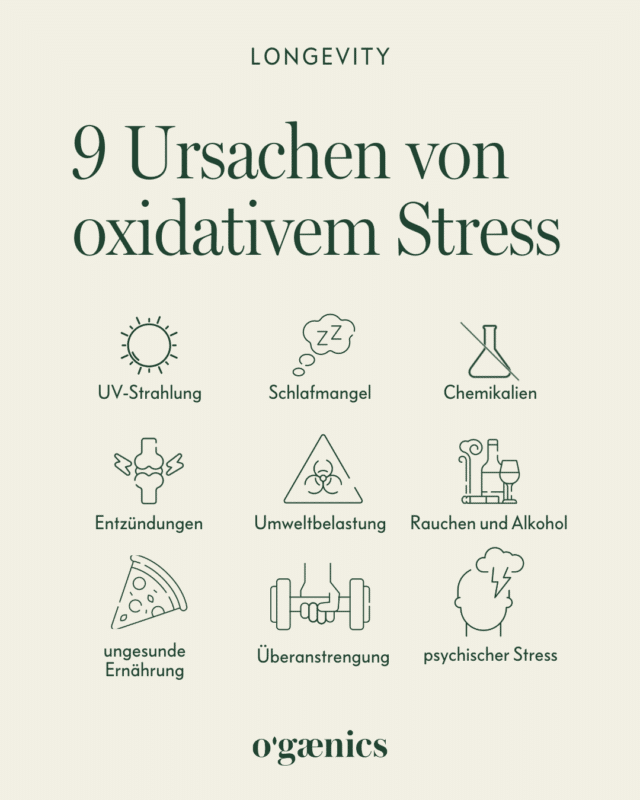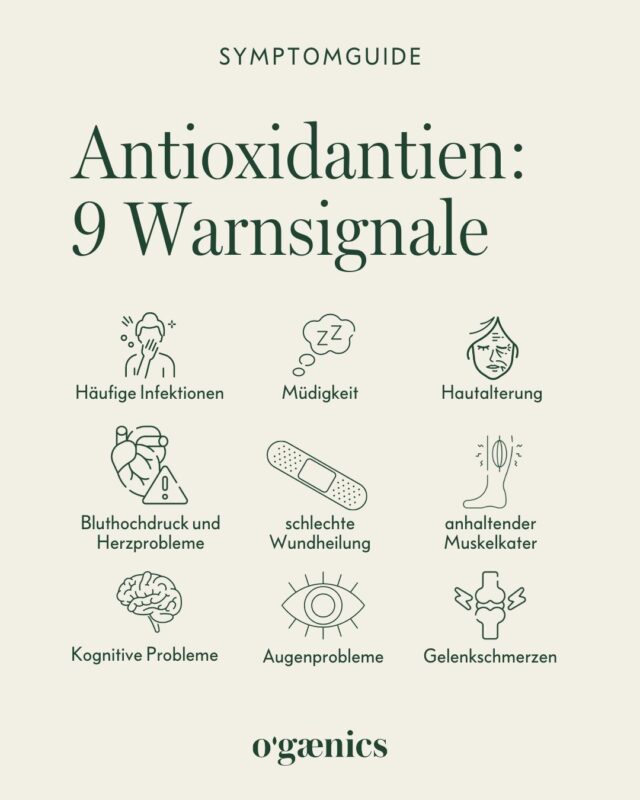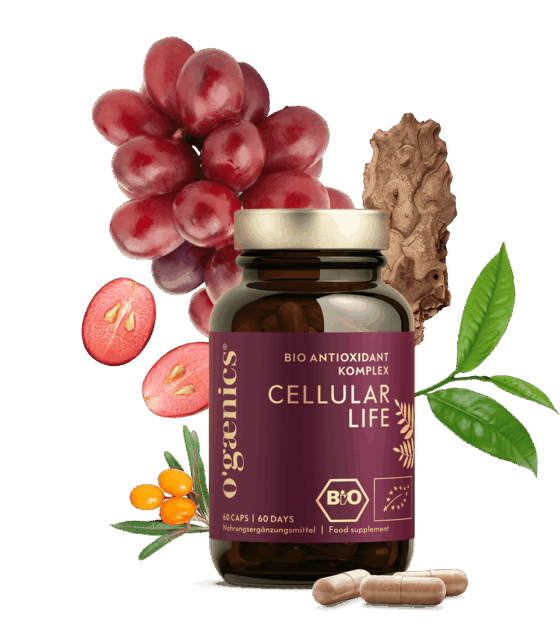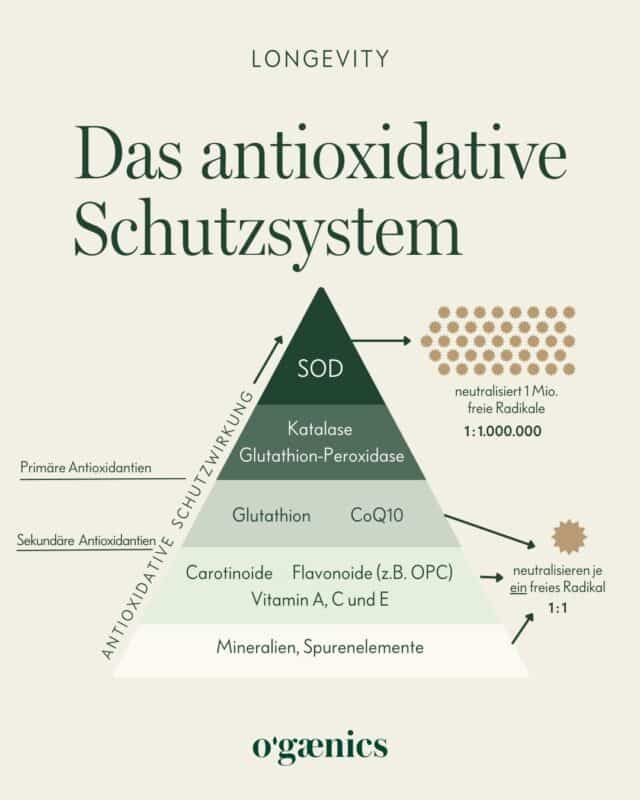IN THIS ARTICLE
01 What are antioxidants?
02 What is oxidative stress and why is it dangerous?
03 How to recognize an antioxidant deficiency
04 The pyramid of the antioxidant system
05 Synergy effects of antioxidants
06 The most important natural antioxidants
07 Antioxidants and longevity
08 Conclusion: Protect your cells with antioxidants
What are antioxidants, how do they work and why are they important for your health?
Antioxidants are considered a protective shield against free radicals and oxidative stress – two factors that play a crucial role in the ageing process and in the development of many diseases. But what exactly are antioxidants, how do they work in the body and why are they so important for our health and longevity? In this blog post, we look at the body’s antioxidant system, the role of antioxidants, the link to oxidative stress and how they can support our health.
What are antioxidants?
Antioxidants are molecules that are able to neutralize free radicals and thus protect the body from cell damage. Free radicals are produced by various processes, such as energy production in the mitochondria, the power plants of the cells, but also by external influences such as environmental pollution, UV radiation, smoking or an unhealthy diet.
Free radicals are highly reactive molecules that lack an electron, which is why they try to steal electrons from other molecules in our body. This process can lead to oxidative stress, which damages DNA, proteins and cell membranes and promotes age-related diseases such as cancer, cardiovascular disease and neurodegenerative disorders.
Antioxidants act as “scavengers” of free radicals by providing them with an electron without becoming unstable themselves. In this way, they prevent the harmful effects and help to protect the cells from oxidative stress.
What is oxidative stress and why is it dangerous?
Oxidative stress occurs when the balance between free radicals and antioxidants is disturbed. If there are too many free radicals in the body and not enough antioxidants to neutralize them, this can lead to cell damage. This can be promoted by various factors:
- Environmental pollution: UV radiation, environmental toxins and air pollution contribute to the formation of free radicals.
- Unhealthy lifestyle: Smoking, excessive alcohol consumption and an unhealthy diet increase the formation of free radicals.
- Physical stress: Intensive physical activity or chronic stress increase the oxidative load.
- Ageing processes: With increasing age, the efficiency of the body’s own antioxidant systems decreases, while the production of free radicals increases.
In the long term, the resulting damage can accelerate the ageing process and increase the risk of chronic diseases, including:
- Cardiovascular diseases(high blood pressure, arteriosclerosis)
- Cancer
- Neurodegenerative diseases such as Alzheimer’s and Parkinson’s
- Chronic inflammation (inflammaging)
To counteract the harmful effects of oxidative stress, it is important to support the body with antioxidant substances.
How to recognize an antioxidant deficiency
A lack of antioxidants can manifest itself in many ways. Here are 9 symptoms that may indicate that your body lacks antioxidants:
- Tiredness and exhaustion: A constant feeling of tiredness, even after sufficient sleep, can indicate oxidative stress.
- High blood pressure and heart problems: A lack of antioxidants can damage the blood vessels and lead to high blood pressure. In the long term, this can increase the risk of cardiovascular disease.
- Frequent infections: A weakened immune system can make you more susceptible to colds and other infections.
- Rapid skin ageing: wrinkles, fine lines and dry skin can be signs that the cells are not sufficiently protected against free radicals.
- Slow wound healing: If wounds are difficult to heal, this may indicate a lack of antioxidants, which are necessary for cell regeneration.
- Joint pain and inflammation: Chronic inflammation and joint pain can be caused by oxidative stress, which in turn increases the risk of inflammatory diseases.
- Cognitive problems: A lack of antioxidants can impair cognitive performance and lead to concentration problems, memory loss or even neurodegenerative diseases such as Alzheimer’s.
- Eye problems: Blurred vision, dry eyes or a deterioration in vision could indicate oxidative damage in the eyes, as occurs in cataracts or macular degeneration.
- Sore and aching muscles: Intense physical exertion can lead to increased oxidative stress. If your muscles are slow to recover, you may have an antioxidant deficiency.
These symptoms may indicate increased oxidative stress, which is exacerbated by an inadequate intake of antioxidants. A balanced diet or dietary supplements such as the Cellular Life Antioxidant Complex can then help you to restore the antioxidant balance.
-
Bestseller
Cellular Life
Certified organic cell protection complex with nature's most powerful antioxidants69,90 €1.815,58 € / kg
The pyramid of the antioxidant system
The body’s antioxidant protection system can be visualized as a pyramid, with each level playing an important role in the fight against free radicals. Free radicals are highly reactive molecules that can damage cells through oxidative stress. Antioxidants protect the cells by neutralizing these free radicals.
The top of the pyramid: primary antioxidants
At the top of the pyramid are the primary antioxidants, which are particularly powerful, such as superoxide dismutase (SOD). These enzymes can neutralize millions of free radicals at once and thus play a key role in the protective system. Other primary antioxidants are
The middle level: secondary antioxidants
In the middle of the pyramid are secondary antioxidants such as glutathione and CoQ10. These substances are also powerful and work closely with the primary antioxidants. They are essential for the recycling process of antioxidants, as they return used molecules to their active form.
The base of the pyramid: nutrients and plant antioxidants
At the base of the pyramid are secondary plant substances such as carotenoids, flavonoids (e.g. OPC) and vitamins A, C and E. These antioxidants neutralize free radicals in a 1:1 ratio and are therefore responsible for the continuous protection of the cells. They work in synergy with the primary antioxidants by creating the basis for efficient cell protection. They are supported by minerals and trace elements that activate the enzymes of the upper levels.
Synergy effects of antioxidants
The antioxidant system is a highly complex network in which all levels work closely together. The base provides important nutrients for the activation of the primary antioxidants, while the higher levels are responsible for the rapid neutralization of free radicals. This synergy ensures that antioxidants reactivate each other, which is crucial for effectiveness.
Isolated antioxidants, on the other hand, cannot maintain this balance and are often less effective. For example, only 0.4 % of the antioxidant effect of an apple is due to vitamin C, while the full effect is only achieved in combination with polyphenols and flavonoids. This makes it clear that whole plant extracts are superior.
Cellular Life from Ogaenics optimally supports this natural synergy effect by providing a complete range of antioxidants, vitamins and minerals that strengthen the entire antioxidant system. With just one capsule a day, the body is fully protected.
The most important natural antioxidants
The following natural antioxidants contribute to cell protection and have an anti-inflammatory effect. Incorporate these nutrients into your daily diet and maintain a healthy lifestyle to slow down the natural ageing process and improve your well-being.
- Antioxidant vitamins (A, C, E)
- Antioxidant trace elements (selenium, zinc)
- Anthocyanins (e.g. in elderberries, red grapes)
- OPC (e.g. in grape seeds, pine bark)
- Phycocyanin (e.g. in spirulina)
- Catechins such as EGCG (e.g. in green tea)
- Superoxide dismutase (e.g. cantaloupe melon)
- Curcuminoids (e.g. in turmeric)
Hyaluronic acid – the underestimated cell protection factor
In addition to classic antioxidants such as vitamin C, OPC and curcumin, hyaluronic acid also plays an important role in cell protection and longevity. It not only protects the skin from oxidative stress, but also helps to keep cell membranes and tissue healthy. Especially in combination with antioxidants, hyaluronic acid can bind moisture, support cell regeneration and have an anti-inflammatory effect. Find out more here: Hyaluronic acid capsules: what they can really do
Antioxidants and longevity
Longevity – the pursuit of a long, healthy life – is closely linked to the management of oxidative stress and the promotion of the antioxidant system. The better the body is protected against oxidative damage, the lower the risk of age-related diseases. Antioxidants play a crucial role in this by promoting cell health and slowing down the ageing of cells.
Conclusion: Protect your cells with antioxidants
Antioxidants are essential for the protection of our cells and the promotion of longevity. They neutralize free radicals, reduce oxidative stress and support the body’s antioxidant system. It therefore makes sense to consume the full spectrum of natural antioxidants instead of supplementing with isolated (often synthetic) substances. The rule of thumb is “Eat the Rainbow” – in other words, consume a colorful variety of foods every day. In addition, supplements such as Cellular Life, which relies on natural, science-based ingredients, strengthen your antioxidant system and cell health. Slow down the ageing process and unlock your longevity!
Store The Story
-
Bestseller
Cellular Life
Certified organic cell protection complex with nature's most powerful antioxidants69,90 €1.815,58 € / kg
- Young IS, Woodside JV Antioxidants in health and disease, Journal of Clinical Pathology 2001;54:176-186. (https://jcp.bmj.com/content/54/3/176)
- Pham-Huy LA, He H, Pham-Huy C. Free radicals, antioxidants in disease and health. Int J Biomed Sci. 2008;4(2):89-96. (https://www.ncbi.nlm.nih.gov/pmc/articles/PMC3614697/)
- Phaniendra A, Jestadi DB, Periyasamy L. Free radicals: properties, sources, targets, and their implication in various diseases. Indian J Clin Biochem. 2015;30(1):11-26. doi:10.1007/s12291-014-0446-0 (https://www.ncbi.nlm.nih.gov/pmc/articles/PMC4310837/)
- Sergio Di Meo, Paola Venditti, “Evolution of the Knowledge of Free Radicals and Other Oxidants”, Oxidative Medicine and Cellular Longevity, vol. 2020, Article ID 9829176, 32 pages, 2020. https://doi.org/10.1155/2020/9829176. (https://www.hindawi.com/journals/omcl/2020/9829176/)
- Huang D. Dietary Antioxidants and Health Promotion. Antioxidants (Basel). 2018;7(1):9. Published 2018 Jan 12. doi:10.3390/antiox7010009. (https://www.ncbi.nlm.nih.gov/pmc/articles/PMC5789319/)
- Wilson DW, Nash P, Buttar HS, et al. The Role of Food Antioxidants, Benefits of Functional Foods, and Influence of Feeding Habits on the Health of the Older Person: An Overview. Antioxidants (Basel). 2017;6(4):81. Published 2017 Oct 28. doi:10.3390/antiox6040081. (https://www.ncbi.nlm.nih.gov/pmc/articles/PMC5745491/)










 No products in the cart.
No products in the cart.